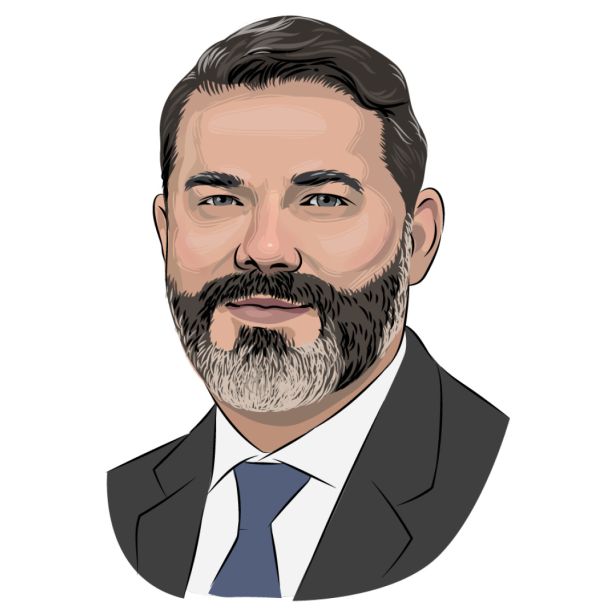
Steven Caldwell
Managing Director and Head of Originations at Barclays

Describe the past 12 months in one word, then expand on your choice.
Challenging. The past year has been one of the toughest for our space, but noting the capital markets are still functioning and active. We are able to originate, distribute and hold risk as well, but the challenge has been managing execution risk. With some of this year’s headlines, movements in base rates alone have pulled deals offline. Views in credit profiles have been ever evolving as well.
Tell us about a recently closed deal you’re proud of, and its biggest challenges/high points.
We recently closed on a large hotel portfolio as part of a deal that had been in the works for several months. As the market rapidly shifted throughout a
longer closing process, it took so much more effort to maintain everyone’s focus. Hotels always get more attention for performance monitoring, so maintaining dialogue with the management teams and attention to detail on how the environment may impact asset-level performance and overall sector strategy was critical to bringing the deal to a successful close.
What are/aren’t you lending on today, and what’s changed in your loan terms?
For balance sheet, we are highly focused on increasing exposure in logistics, medical office buildings, and looking at data center opportunities. Every deal is addressing the higher rate environment, but, based on cap rate, some are more severely impacted than others. As we think through where we want to lend and asset quality, we are facing how to respond to limited coverage. We are now requiring additional credit enhancement from sponsors, including carry guarantees, for example, which are now being executed with significantly longer tails.
Name two markets you’re gravitating toward today.
Our on-book lending strategy is focused on geographically diversified portfolios with fresh equity as opposed to wanting to build exposures in specific markets. That said, most conversations I have with clients and colleagues are around the flip side of that question: “Which office markets concern you the most?” That is a little unfair and sensational, since I think inventories and utilization is more fragmented than the broader market really appreciates.
One of the most interesting markets to discuss (in good times and bad) is San Francisco. From a recent visit with clients there, the overwhelming theme after now seeing some recent asset sales and leasing activity is the impending FOMO from equity investors on what they anticipate being once-in-a-lifetime buying opportunities. I think lender interest is far behind that sentiment, but it will be a closely watched part of the market.
Has certain lenders’ retrenchment been beneficial to your pipeline? Discuss.
Absolutely. CMBS was designed to create liquidity for CRE credit in a distressed macro environment. So, as other forms of capital have pulled back, the ability to create pooled risk has a lot of appeal to those who like the asset class overall, who are now being rewarded with a strong yield opportunity regardless of where they participate in the capital stack.
While total conduit production is robust, SASB has been more challenging. The yield premium for single-asset credit risk is significant, but yield isn’t the solution for every deal. Some transactions aren’t executable in this environment and will ultimately need capital stacks to be restructured to be able to execute in the SASB space.
What scares the bejesus out of you in today’s market?
Higher for much, much longer, which might be the result of additional government stimulus undermining the Fed’s quantitative tightening (QT) initiative. Borrowers deal with rate adjustments at major milestones, either maturity dates or extension dates when buying new cap.
A lot of borrowers are mentally stressed by thinking about higher rates but haven’t actually experienced an adjustment yet, particularly if they’re fixed-rate borrowers. If the tail on QT is extensive, more borrowers will be passing through those milestone dates and be forced to address the cost of rate cap purchases or potentially restructured capital stacks.
Lightning Round:
Multifamily or Industrial?
Industrial.
Taylor Swift or Beyoncé?
TSwift. (My daughter would kill me if I didn’t!)
What would be the title of your Lifetime biopic?
“Om: a Guide to Mental Health in the Workplace.” Just kidding, I’m always calm and collected! I would say “It Takes a Village” since really any long-term individual or team success in our business requires you to build off the expertise of the team’s components and build consensus.
‘Ride or dies’ only (relationship borrowers) or taking on new borrowers?
We like both. We stand by our long-term clients in this challenging environment but are also welcoming new borrowers who need financing on strong real estate.
Vacay time: Mountains or beach?
Mountains — every time.
Complete this sentence: If I weren’t a lender I’d be…
An engineer or a mechanic. Or, really, I’d just love to rebuild classic cars. I really enjoy the process of engineering and building. I had an amazing experience as a geotechnical/tunnel engineering student and intern (and still have my design drawings for the MTA from 25 years ago), but now I’m more interested in things that move.

